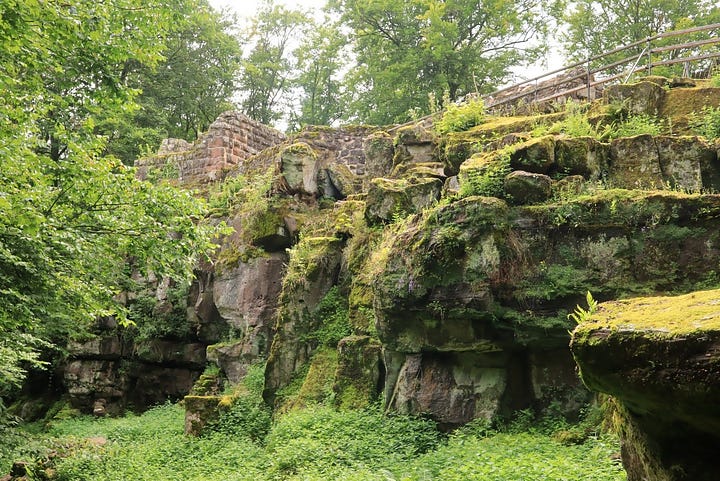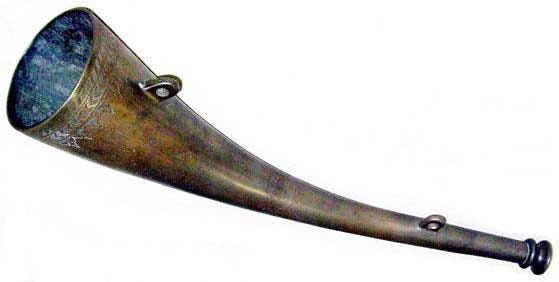I set off on a day’s hike from the town of Lahr, armed with a backpack of snacks and a vague sense of direction, when I almost literally stumble across two ruins: Burg Lützelhard and Burg High Geroldseck.
I’m no history geek, but coming across not one but two ancient fortresses on the same trail, I feel sure I’ve got my next Substack post covered. I take a deep breath, tighten my hiking boots, and prepare for a journey through time and an impromptu workout.
Both forts, I can read in the hiking app, once guarded the access routes into the Black Forest from the Rhine River. These access routes went through to the Kinzig Valley, the home of precious metals and an endless wood supply.
As I reach Burg Lützelhard, hidden in the woods like a gloomy pagan temple, I can read the legend that I suspect is what’s keeping its memory alive:
The legend says that the Lord of Geroldseck was held captive in Lützelhard for two years. He’d been captured and brought here blindfolded so he might not suspect he was so close to his home. He spent two years in the darkest vault until one day, he heard the brass horn in Burg Lahr, and then he realised where he was. As a liege lord of the entire estate, it was easy for him to get the guards to help him escape.


I start searching online. Whatever their motive, I wonder why they were keen to detain instead of kill him. And why did he have to be kept in the dark as to his whereabouts?
I reach Burg High Geroldseck, and I enjoy the birds-eye view and the birds-wing feeling of soaring over walls and trees from the roofless tower. I read in the app that on one of the mountains in the Kinzig Valley, there’s a hut: in June, before the solstice, you can see from there the sun setting directly behind Burg High Geroldseck.


I get back home and think again of the legend: a hero, his antagonist – and a brass horn.
The two men would chatter about their feud, each with their justifications.
The horn, however, could be my most precious witness. There must have been a special bond if the Lord of Geroldseck heard its sound and knew at once where it came from.
I read it’s kept in the Lahr Museum.
If I’m quick enough, I can get its testimony just in time before posting on Substack Sunday morning.
“My master forged me in the backyard of his old castle, Old Geroldseck,” the brass horn sighs.
“The stately Old Geroldseck tower, that’s where he used to stand, peering down the Schönberg mountain, into the Kinzig Valley, then turning right to the wooded mountain where his mines were.”
“He owned mines, too?” I ask naively.
“Oh, yes,” the horn blows out a rusty breath. “He owned the silver and the copper in his mines, like the crops on his farming lands and orchards, plus the trout in many a mountain creek and the game in his forests.”
“A handsome livelihood,” I reflect. “I reckon he was a busy man, with so much that he owned? Did he have time for any hobbies?”
“My master, Lord Walter of Geroldseck, was a multi-sided talent. He crafted tools that made even his chief blacksmith green with envy. He worked his forge between fighting battles and farming lands, between hammering for ore down his mine shafts and distilling schnapps.”
“Wait, he actually dug for ore and pushed the plough?” I exclaim in disbelief.
“My master could hold the sword just as deftly as the plough. He had a collection of shiny ore pebbles on the window sill, which he’d hammered out himself.
“And me – well, I was one of his favourite works. He would hold me in his hands and blow sad tunes of a lonely evening,” the brass horn spoke in a thin voice, strangled with emotion.
This piece of tin had better stick to the facts, I tell myself. I have a deadline to meet tomorrow morning.
I want to know what role it played in the legend that’s being passed on about how Walter of Geroldseck owed his life to this brass thing.
“He’d visited his cousin, the Bishop of Strasbourg, and heard the gloomy sound before the evening mass.
‘What sound is that, beloved cousin?’ he asked the Bishop.
‘Oh, that’s our new contraption, made with copper from your mines in the Kinzig Valley!’ the Bishop patted him on the shoulder.”
“I don’t have so much time today, little thing,” I prompt the chatty museum piece. “Can we skip your tale of origin?”
“Of course, please pardon! Suffice it to say that Lord Walter of Geroldseck, upon his return to his fortress, set his mind to forging a brass horn just like his cousin’s. That is how I came to be.”
I wait. I’d asked about the legend, not how its master had forged the contraption.
“Right, sure,” it clears its voice. “He kept me for a year or two until Burg Lahr, which was being erected under his command, was completed. He gave me as a gift and token of his protection of the town. The sentry was to use me only when an army should be approaching.”
The curator is standing in the doorway, smiling at me but pointing at her watch. Closing time, soon. I nod and turn back to the horn.
“What about that legend? Can we get to the point?” I press on.
“Sure,” he replies, unperturbed. It certainly has all the time in the world, hasn’t it?
He resumes, “The Knight Diebold of Lützelhardt had long been envious of my master. Geroldseck and Lützelhard were too close, some used to say, and watching over the same Kinzig Valley and the same riches. Of course, Diebold was my master’s servant, but a servant who’d built a fortress and a small but brave army.
“He hatched a cunning plan and lured my Lord to a hunt. After sun-down, a few men came from behind and tied my Lord and folded his eyes. They carried him on horseback for two days; round and round and round they went until my master thought he was over the mountains. They put him in the darkest vault in Lützelhard and left him there, unknowing of his fate.”
“But wait, why all the secrecy? And why didn’t they just kill him?” I’ve been waiting for the story to get to this point.
“He mustn’t know who the perpetrator was, of course”, the horn replies condescendingly. “If he’d known where he was, he would have been able to get help. After all, Lützelhard was on his estate; he was the liege lord to everyone from Diebold to the last servant.
“Besides, Diebold was the Lord’s chief knight. He was to administer the Geroldseck estate whenever the Lord was absent. On his death, however, the estate would be passed on to his eldest son. So Diebold told my master’s family that during the hunt, he’d decided to stay in a forest hut to await God’s illumination and that he wished not to be disturbed until he returned of his own accord. In the meantime, he had the power over the entire Geroldseck estate.”
“But that’s just gambling for time”, I cut in, scoffing.
“Of course,” the horn agrees, “aren’t you humans doing that all the time?”
It has a point.
But time is running out.
“Right,” it resumes. “What else do you want to know?”
“So they kept your master there for two years until he finally heard you. What took him so long?”
“Well,” the horn chimes almost ironically, “I guess you haven’t been listening? I said I’d been gifted to Burg Lahr for use in case of danger. It took two years for an army to head down to Burg Lahr. It was the Bishop’s army, my master’s cousin, but it was still an army. The sentry in the Tower blew me, and I gave the best of my lungs,” the horn chuckles. “My master could tell my sound from a dozen horns.”
“He must have felt like a fool when he realised he’d been so close all along,” I think aloud. “But what did the Bishop want? I thought he was your master’s ally.”
“He was, in truth. But what can a poor horn know?”
It goes silent, but I’m still waiting.
“So? What was the Bishop’s army doing, riding to Lahr?”
If a horn could shrug, that is what the brassy thing might be doing now.
“This is the story as told by a brass horn, remember?” the horn aptly points out. “What do I know? Maybe the Bishop had tired of waiting for my Lord to come out of the forests and was willing to put Fort Geroldseck under his own protection?”
I purse my lips. Is this sorry relic going to leave me hanging? Wait a minute!
“If this is merely a story told by a brass horn, how do you know everything you’ve just told me?”
I could swear I just heard a giggle. But there’s nobody else in the room. Who should be so passionate about Lahr’s history on a Saturday afternoon?
Is the bloody horn making fun of me and is now giggling?
“You’re forgetting, young lady, that I’ve been hanging out in a museum for ages. Plenty of time to engage with others and hear the gossip,” the horn concluded with a hissing laugh.
I did some more reading, too.
What happened after Lord Walter of Geroldseck escaped from his captivity?
He came down on Lützelhard with his men and razed it to the ground. He must have taken great pleasure killing Diebold with his own sword.
A few years later, he built a statelier fort, Burg High Geroldseck, and moved in, leaving the old one behind. It’s the burg we see nowadays.
There are no traces of Diebold’s descendants.
The Geroldsecks died out, too, but some two hundred years later. Their fort went over to another family.
The Geroldseck fort has been the property of the same family for the past four hundred years.
It still towers majestically over the valleys that crisscross the neighbourhood.
Burg Lützelhard is overgrown by woods and sinking into oblivion.
But after all, they’re both ruins.





